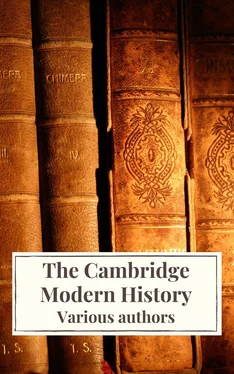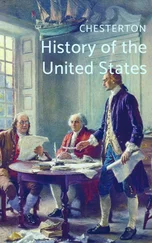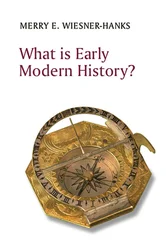R. Nisbet Bain - The Cambridge Modern History
Здесь есть возможность читать онлайн «R. Nisbet Bain - The Cambridge Modern History» — ознакомительный отрывок электронной книги совершенно бесплатно, а после прочтения отрывка купить полную версию. В некоторых случаях можно слушать аудио, скачать через торрент в формате fb2 и присутствует краткое содержание. Жанр: unrecognised, на английском языке. Описание произведения, (предисловие) а так же отзывы посетителей доступны на портале библиотеки ЛибКат.
- Название:The Cambridge Modern History
- Автор:
- Жанр:
- Год:неизвестен
- ISBN:нет данных
- Рейтинг книги:4 / 5. Голосов: 1
-
Избранное:Добавить в избранное
- Отзывы:
-
Ваша оценка:
- 80
- 1
- 2
- 3
- 4
- 5
The Cambridge Modern History: краткое содержание, описание и аннотация
Предлагаем к чтению аннотацию, описание, краткое содержание или предисловие (зависит от того, что написал сам автор книги «The Cambridge Modern History»). Если вы не нашли необходимую информацию о книге — напишите в комментариях, мы постараемся отыскать её.
The first series was planned by Lord Acton and edited by him with Stanley Leathes, Adolphus Ward and George Prothero.
The Cambridge Modern History Collection features all five original volumes:
Volume I: The Renaissance
Volume II: The Reformation, the End of the Middle Ages
Volume III The Wars of Religion
Volume IV: The 30 Years' War
Volume V: The Age of Louis XIV
The Cambridge Modern History — читать онлайн ознакомительный отрывок
Ниже представлен текст книги, разбитый по страницам. Система сохранения места последней прочитанной страницы, позволяет с удобством читать онлайн бесплатно книгу «The Cambridge Modern History», без необходимости каждый раз заново искать на чём Вы остановились. Поставьте закладку, и сможете в любой момент перейти на страницу, на которой закончили чтение.
Интервал:
Закладка:
Spain and the Netherlands thus became rival centres in a movement which was profoundly Catholic. It sprang up in Northern Europe under the influence of the Dominican Friars; south of the Pyrenees it was due to the Benedictines and Franciscans. A third element, derived from the writings of St Augustine and the Rule called after his name, is more difficult to estimate. St Augustine had ever been the chief Western authority in the Schools as in the Councils. He, though no infallible teacher, formed the intellect of medieval Europe. But the Cathari or Waldensians were fond of quoting him as the patron of their anti-sacerdotal principles, and in the vehement polemics of Luther he is set up against Aquinas. From Deventer, then, we may trace the origin of a reforming tendency which, passing by Alcalä and Toledo, takes us on to the Council of Trent. In that assembly Spanish divines, Laynez or Salmeron, vindicated the scholastic tradition, while Popes under Spanish protection tightened discipline and recovered, though late, their lost moral dignity. But from Deventer likewise another movement issued forth, in which John of Goch, Wesel, and Gansfort led up to Erfurt and Wittenberg-to the new doctrine of justification by faith alone, and to an independent type of religion.
In these two Reformations, Catholic and Protestant, it will be observed that England, France and Italy play secondary parts. To the ideas which inspired Thomas ä Kempis, Luther, or Loyola-creative or revolutionary as they might be-no English thinker except Occam contributed. Nor did a single French writer anticipate Calvin. And the Italians, almost wholly given up to art or letters, and at no time much troubled with the problems which divided the Schools in Paris, might seem to have been incapable of grasping a spiritual principle in its pure form, until they were subjugated by the Jesuit masters who came in with the Spanish dominion.
Yet, as in England religion had no quarrel with learning but was revived in its train, so among Italians the impressive figure of Savonarola warns us that prophets after the manner of the Old Testament were not wanting, even to the heyday of a Classical Renaissance. True, the English humanism did but serve to usher in a period, Elizabethan or Jacobean, which was not Catholic according to the Roman style; and Savonarola was burnt. Yet on the eve of the Reformation these more spiritual influences were not extinct in the Church; they might have been turned to a saving use; and for a while the orthodox hoped it would be so. Frä Girolamo, Bishop Fisher, Sir Thomas More, have always been regarded by those who shared their faith as martyrs in the cause of a true Christian morality and as harbingers of a reform which they did not live to see.
In the Low Countries, therefore, from the appearance of Tanchelin, about 1100, and after the growth of Waldensian opinions, though these were by no means peculiar to the Netherlands, much had been done by authority to suppress or convert dissidents. The Black Friars of St Dominic were called to Antwerp as early as 1247. They acquired almost at once a power which was chiefly exercised in spiritual direction; their many disciples followed a way of life pure, detached, and simple-the way of the heart rather than the intellect. Another sign which accompanied them was the multiplying of Third Orders, in which men and women, not bound by vow or shut up within a cloister, strove to lead the higher life. These sodalities must not be confounded with the Turlupins, Beghards, or Brethren of the Free Spirit-ecstatic, perhaps antinomian fraternities-condemned by Pope John XXII and abhorred of all good Catholics. If we would understand what precisely was the Dominican training, a delightful instance has been left us in the correspondence of Christine de Stommelin (1306). But the finest example as the most celebrated of Flemish masters in the fourteenth century is the “admirable” Ruysbroek, an earlier Thomas ä Kempis, who adorns the period which lies between 1283 and 1381, and whose son in the spirit, Gerard Groot, gave a new and lasting significance to the school of Deventer.
That “flight of the alone to the Alone,” which we call Christian mysticism, had found no unworthy expression in St Thomas Aquinas, the Angel of the Schools, who reasons by set syllogism on all things in heaven and earth. He had sealed with his authority the books, translated by Scotus Erigena, which were long attributed to Dionysius the Areopagite, but which are now known to be a production of the fifth century and of the Alexandrian, or even Monophysite, metaphysics. With severe negations, not wholly foreign to Plotinus, they limit, by exceeding them, the affirmations of the School theology; in the paradoxical phrase of Cusanus, their teaching is a “learned ignorance”; but they exalt the earthly as a shadow of the heavenly hierarchy; and they leave to our adoring worship the man Christ Jesus. From the defilements of sense, the scandals of history, the misuse of holy things, they turn to an inward, upward vision and celebrate the hidden life. It is well known that Eastern hermits joined the work of their hands to prayer; that cenobites under the Rule of St Basil copied manuscripts, studied the Scriptures, and taught in schools, especially the children of the poor. Brought from the plains of the Euphrates to the wild heaths or grassy meadows of Rhine and Yssel, this secret doctrine found in Ruysbroek an Areopagite, in Gerard Groot and Florentius Radevynzon the masters of its practice, who combined meditation with handicraft, and both with sacred and secular studies.
Of these men mention has already been made in another chapter of the present volume, which deals with the Netherlands. Groot’s institution, closely resembling in idea the first thought of St Francis, was at Constance opposed by the Dominican Grabo, but defended by Gerson. It may be remarked in passing, that Gerson-unfairly according to the best judges-criticised the language of Ruysbroek’s Ornament of the Spiritual Marriage as tainted with pantheism. In 1431 Eugenius IV approved the Brethren of the Common Life. Pius II and Sixtus IV showed them much kindness. Florentius, after establishing his Austin Canons at Windeshem, died in 14<00; but his scheme of education prospered. Gerard Zerbold of Zutphen governed and taught in a similar spirit. The communities of Sisters fell off in some measure. On the other hand, Groot’s foundation at Zwolle developed into a house of studies under John Cele, and drew scholars from every side-from Brabant, Westphalia, and even Saxony. In 1402 seven monasteries looked up to Windeshem as their mother-house. The congregation spread into Germany. In 1409 tumults at Prague, with which University Groot’s leading disciples had been associated, drove out thence a multitude of students who had embraced the system of Nominalism. They flocked to Deventer, Zwolle, and the other Flemish towns where that system was upheld against the extravagances of an overbearing Realism. The convent and library of le Rouge Cloitre, in the Forest of Soignies, became very celebrated. In these retreats of contemplatives, kept wholesome by hard manual labour, the Scriptures were copied and read; the text of the Vulgate was corrected; a treasure of devout wisdom was silently gathered up, whose most precious jewel is the book written by Thomas ä Kempis, though it did not bear his name. Within thirty years Windeshem had given rise to thirty-eight convents, of which eight were sisterhoods and the rest communities for men of a strict yet not unreasonable observance. To the Austin Canons established by Florentius we may trace a main current in the Catholic Reformation; the Austin Hermits ended in Staupitz and Luther.
Education was the daily work of many among the Brethren. Their school at Hertogenbosch is said to have numbered twelve hundred pupils. In Deventer they taught in the grammar-school, and “here in the mother-house I learned to write,” says Thomas Bemerken, who came thither from Kempen as a lad of twelve. Florentius gave him books, paid his school fees, was a father to him. Unlike Groot, who had taken his degree at Paris, Thomas attended no University. He was taught singing; he practised the beautiful hand-in which he copied out the whole Bible; he travelled on business for the monastery, but was away only three years altogether; at Mount St Agnes he spent just upon seventy years. The key-note of his life was tranquillity; he perhaps called his book not, as we do, the Imitation of Christ, but the Ecclesiastical Music. A reformer in the deepest sense, he accepted Church and hierarchy as they existed, and never dreamed of resisting them. Everything that the sixteenth century called into question is to be found in his writings. He availed himself of an indulgence granted by Boniface IX; he held the Lateran teaching on the Eucharist; he speaks without a shadow of misgiving of the veneration of Saints, of masses for the dead, lay Communion in one kind, auricular confession and penance. To him the system under which he lived was divine, though men were frail and the world had fallen upon evil days. Those, therefore, who seek in The Imitation vestiges of Eckhart’s pantheism, or pro-phesyings of Luther’s justification by faith alone, fail to apprehend its spirit, nor have they mounted to its origin. For Ruysbroek is emphatic in asserting free-will, the necessity of works as fruits of virtue, the Grace which makes its recipient holy. Such is the very kernel of Thomas a. Kempis, in whom no enthusiast for antinomian freedom would find an argument. And in a temper as active, though retiring, as dutiful though creative, the movement went on which had begun at Deventer. Thomas records in a series of biographical sketches how his companions lived and wrought. When we arrive at Cusanus, we feel that there could have been no worthier preparation for measures of amendment in the Church at large than this quiet process of self-discipline.
Читать дальшеИнтервал:
Закладка:
Похожие книги на «The Cambridge Modern History»
Представляем Вашему вниманию похожие книги на «The Cambridge Modern History» списком для выбора. Мы отобрали схожую по названию и смыслу литературу в надежде предоставить читателям больше вариантов отыскать новые, интересные, ещё непрочитанные произведения.
Обсуждение, отзывы о книге «The Cambridge Modern History» и просто собственные мнения читателей. Оставьте ваши комментарии, напишите, что Вы думаете о произведении, его смысле или главных героях. Укажите что конкретно понравилось, а что нет, и почему Вы так считаете.












